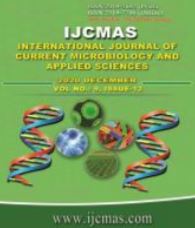


 National Academy of Agricultural Sciences (NAAS)
National Academy of Agricultural Sciences (NAAS)

|
PRINT ISSN : 2319-7692
Online ISSN : 2319-7706 Issues : 12 per year Publisher : Excellent Publishers Email : editorijcmas@gmail.com / submit@ijcmas.com Editor-in-chief: Dr.M.Prakash Index Copernicus ICV 2018: 95.39 NAAS RATING 2020: 5.38 |
Rhizoctonia bataticola (Taub.) Butler is the causal organism of dry root rot of chickpea. Its Pycnidial stage is found in Macrophomina phaseolina (Tassi) Goid. It is soil inhabiting fungal pathogen. Keeping in view the consequentiality of the disease due to transmute in climatic conditions, studies were conducted on distribution of the disease, cultural, morphological, pathological and molecular diversity. This research was conducted at Department of Plant Pathology, CSAUA & T, Kanpur, in collaboration with Indian Institute of Pulses Research, Kanpur. In this research, dry root rot affected samples were collected from different farms of Uttar Pradesh. A total of fifty R. bataticola isolates of were isolated from these samples. Eight different culture media were used in this study for evaluation of the best for growth of Rhizoctonia bataticola. The fungus R. bataticola gives maximum cultural growth on potato dextrose agar (88.63 mm) followed by corn meal agar 78.36 mm and oat meal agar 73.36 mm while potato dextrose rose bengal agar showed least growth of 28.50 mm in solid media. Among the eight liquid broth media tested, potato dextrose broth revealed the highest mean mycelial dry weight (158.50 mg) followed by corn meal broth (130.90 mg), oat meal broth (127.60 mg), V-8 juice broth (119.10 mg) while potato dextrose rose bengal broth gives the least mycelial dry weight (53.60 mg). Production of sclerotia was maximum in PDA and least in SDA.
 |
 |
 |
 |
 |